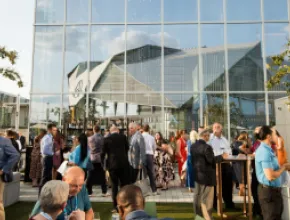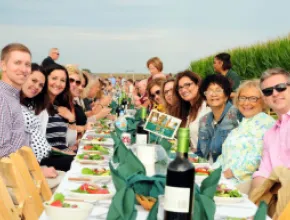From the days when Mormon leader Brigham Young was a perpetual thorn in the side of the U.S. government, due to his colony’s aberrant ways, up until only about a dozen years ago, it never seemed that becoming a top-draw meetings destination was in the cards for Salt Lake City.
Owing primarily to its standing as the headquarters of the socially conservative church and Utah’s stringent liquor restrictions, Salt Lake often received short shrift whenever the topic of fun destination cities came up—meetings included.
But things have changed for this picturesque city nestled beneath the Wasatch Mountains. In 2002, Salt Lake and neighboring Park City hosted the Winter Olympics, and they both built up significantly in preparation. Suddenly a global magnifying glass was focused onto this relatively small and humble city, and the world took notice of its seven world-class ski resorts, pristine setting and comfortable feel.
Since then, in addition to the surge in new hotel rooms and event space for the Olympics, the city has invested significant sums into revitalizing its downtown core. In 2006, the Salt Palace Convention Center received a $58 million overhaul and expansion that raised its total meeting space to 679,000 square feet. Another major project, the City Creek Center, will include up to $2 billion in retail and residential development, restaurants and boutique shops.
Meanwhile, as the city embraced its newfound recognition and tourism increased—primarily for outdoor recreation—it also began to shed the reputation of its homogenous culture (including being all-white, all-Mormon). In fact, today 22 percent of the population is Hispanic, and the city has a sizeable gay community.
But one issue still remained, a not-insignificant quirk that kept many jolly imbibers at bay—the Prohibition-era mandate that alcoholic beverages could only be served to an individual if they completed a permit and paid an annual fee for that particular establishment. In March, Utah Gov. Jon Huntsman signed a bill that nullified this requirement, essentially making all of the state’s clubs and bars accessible to anyone over 21 years of age, without any further requirements.
And then came the coup de grace for the meetings industry: Salt Lake City hosted the 2009 MPI-WEC convention. While no city CVB would be jumping for joy at the prospect of taking the stage directly after Las Vegas (with record-breaking attendance and in a still-thriving economy), the people at the Salt Lake CVB (SLCVB) were anxious to illustrate in what ways this city differs from the "City of Sin," while at the same time show off its similar modern qualities.
"[MPI] not only exceeded our expectations, but it exceeded the expectations of everyone involved, most important of all the attendees," says Scott Beck, president and CEO of the SLCVB.
Whereas Las Vegas does not have to go out of its way to show meeting planners what it is all about—just about anyone in the world can picture its legions of themed hotel rooms, glamorous nightclubs and showy casino floors—Salt Lake benefited immensely from having the opportunity to give planners a taste of its unique character.
"As with most of our potential clients, the vast majority of the WEC attendees had not been to Salt Lake," Beck says. "We can talk about our accessibility, natural environment, restaurants and nightlife scene—and often do until we are blue in the face—but it is not until someone lands at our airport and is at their hotel 10 minutes later that they believe it. It is not until they actually experience that our mountains are so close you can almost touch them that they believe it, and last but not least, it is not until you get a drink in a cool brew pub or nightclub that you believe you can do that in Salt Lake City, Utah."
Salt Lake City
With a greater metropolitan population of just over 1 million and an urban population of just a fifth of that, Salt Lake is not a large city. Yet, with the infrastructure and experience of hosting the Olympics and MPI, you get the best of both worlds—small-town ease and intimacy combined with larger-city meetings potential.
"They have such a terrific meetings industry in the city," says Bridget Sypolt, director of events for MPI. "The convention center and the hotels that feed into it are all very walkable; you are constantly running into your group, so it feels very close together. There are plenty of restaurants and bars in that same small area, so there are plenty of things to walk to in the evening."
As the head planner for this past summer’s MPI-WEC convention, Sypolt had been examining the city’s meeting capabilities for several previous years. For her, the fact that the airport is only 10 minutes from downtown, the accessibility to outdoor recreation and the walkability of the convention area are huge selling points for planners. She also points out that the Red Butte Outdoor amphitheatre, which was used for MPI’s closing night event, was a smashing success.
"The event received tremendous satisfaction scores from our attendees, and so we were very happy with the city," she says. "As you can guess, our audience is pretty picky!"
In addition to the amphitheatre and the Salt Palace Convention Center (which received silver LEED certification following its ’06 facelift), planners will find 80,000 square feet of meeting space at the city’s signature property, the AAA Five-Diamond Grand America Hotel, offering 775 guest rooms. Its sister property, the Little America Hotel, along with the Salt Lake City Marriott Downtown and Hilton Salt Lake City Center, are excellent options for midsize meetings. Not far from downtown, the South Towne Exposition Center features 243,000 square feet of meeting space.
When it comes to free time, most visitors look up to the mountains surrounding the city, and rightly so. But there are many sights in town that can be experienced all in an afternoon. Adjacent to each other, Temple Square, the Church History Museum and the Beehive House (Brigham Young’s former home) provide a comprehensive perspective into the fascinating history of the Mormon faith. The Utah Museum of Art presents more than 17,000 pieces of fine art, while the McCune Mansion, built in 1900, is an excellent choice for off-site dinners or cocktail parties.
Park City
Park City is the kind of place where the names of the events it hosts are better known than the destination itself. The reputation of the Winter Olympics, three premier ski resorts, the fully operational Utah Olympic Park and the Sundance Film Festival is enough to draw enthusiasts from all over the world to this church of mountain recreation just over a half-hour from Salt Lake City.
Utah Olympic Park, currently used as a four-season training facility, allows visitors to experience such rare thrills as tearing down a bobsled track at eye-blurring speeds, and is an ideal option for custom team-building programs or an unforgettable incentive trip.
Aside from snow pursuits, however, the town is a beautiful place for summer meetings. Recreation options include golf, horseback riding and endless hiking and mountain biking, while in town visitors can enjoy outdoor dining and the relaxed pace of a mountain town.
Among the destination’s many meetings-ready property choices for groups are The Canyons Grand Summit Hotel at The Canyons Resort; Yarrow Resort Hotel and Conference Center; Stein Eriksen Lodge; and Hotel Park City. The town’s luxury stock is rising with the addition of both the Dakota Mountain Lodge, part of The Waldorf Astoria Collection, as well as a St. Regis.
A popular off-site venue, the Egyptian Theatre was built in 1926 and produces a number of performances per year. Naturally a centerpiece for the Sundance Film Festival, the 266-seat auditorium is an impressionable choice for awards ceremonies or private screenings. The town also boasts a number of eclectic art galleries, several of which can be used for small receptions.
Hunter Holcombe is a freelance writer who covers leisure travel and the meetings, conventions and incentives industry.






